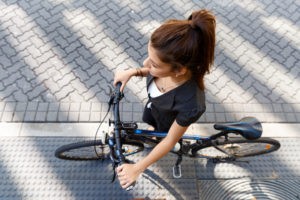Everything You Need to Know About Bicycle Commuting in Florida
Are you ready to take the leap from bicycling for fun into bicycling for transportation? Some advance preparation will make your transition to bicycle commuting more successful. Some factors to take into account are:
What Equipment should a Bicycle Commuter use?

The most important piece of equipment for bicycle commuting, of course, is the bicycle itself. While any bike can be used as a commuter with some modification, some designs are more practical and comfortable for riding on city streets. Some may also be suitable for both commuting and weekend riding, but if you prefer mountain biking or racing, you may want to consider a different bike for commuting. Features to look for in a commuter bike are:
- Handlebars: Flat handlebars are more comfortable for commuting than the drop handlebars found on racing bikes. The upright riding position allows the rider better visibility in traffic and is more relaxing.
- Tires: Bicycle tires for commuting are usually narrower than road tires, but wider than mountain bike tires. Tires for commuting on city streets should have good traction and durability for daily use. Puncture resistant tires are heavier than regular tires but may save a lot of time and trouble. Tubeless tires are becoming more popular with commuters. With a tubeless tire, the sealant can be added to repair small punctures as they occur, greatly reducing the chance of flats.
- Gears: If your commuting route is fairly flat, a fixed gear bike may be a good option. The main advantage of a fixed gear bike is low maintenance, but it may feel unusual when you first start riding, as there is no freewheel, meaning that you must be pedaling at all times. A bike with an internally geared hub may be a good alternative to a fixed gear bike – the chain does not move when the gear is changed, making the bike easier to maintain.
- Crossbars: A “step through” bike with a low crossbar is practical if you wear a skirt or dress, and can also make it easier to stand, a good feature when you have to stop for cross traffic or signals.
- Folding bikes: If you prefer not to leave your bike outside while you work or if your commute involves a bus ride or other public transportation, a folding bike may be suitable for you. A folding bike won’t handle exactly the same as a regular bike but can be stored almost anywhere.
Accessories for Florida Bicycle Commuters
- Mudguards and chain guards are essential for commuter bikes unless you want to arrive at work with grease or mud on your clothes.
- Racks or baskets may be used to carry items if you do not want to wear a backpack.
- A good, sturdy lock is a must.
- If you are commuting early in the morning or in the evening, look into USB rechargeable lights. Experienced bike commuters always say that you can’t have too many lights. Both a headlight and a tail light are necessary for the best visibility, for you and for the traffic around you.
- A helmet is necessary for any rider, especially if your ride takes you into traffic. A foldable helmet offers the protection you need but is easier to carry into the office.
Maintenance for your Commuter Bicycle
If you don’t have puncture-resistant tires, you may consider keeping a toolkit handy with a portable pump, patches, and perhaps an extra tube. A multi-tool for adjusting your chain, seat, or handlebars may also come in handy.
Take a class, watch a video, or read an article on basic bicycle maintenance before you begin your commuting adventure.
The Rules of the Road
- On public streets, bicyclists must obey the same traffic rules as motorists, including obeying traffic signals.
- Travel in designated bike lanes when available, and as far to the right as possible when there are no designated lanes.
- Do not dive on the sidewalk.
- Do not wear headphones.
- Use hand signals for turning.
- Use a bell to let pedestrians and other cyclists know you are there.
- Do not assume that the driver of a car can see you.
How To Make Your Commute More Pleasant
One of the biggest challenges of commuting on a bicycle is what to wear. If the weather is fairly mild and you have good mudguards and chain guards, you may feel comfortable riding in your regular work clothes. Some commuters look for clothing that is suitable for work but is still comfortable and breathable. Others prefer to take a change of clothes in a backpack. Some commuters leave an emergency change of clothes at the workplace, in case of a sudden rainstorm, fall, or unfortunate splashing accident.
Scope out your route before your commute. Take a ride to your workplace on anon-work day, to get an idea of the amount of time you will need for your commute, and to find the best route. You may opt for a slightly longer commute if it has better bike paths or safer roads. After all, commuting by bicycle is supposed to be enjoyable. If it is too much of a chore, you won’t want to do it.
Commute when you want. You are not required to take your bike to work every day. Start with one or two days per week, and if that works out, make it full-time. Don’t feel bad about getting the car out if the weather is bad, though. Leaving the car at home even one day a week will be beneficial to your health and the environment.


